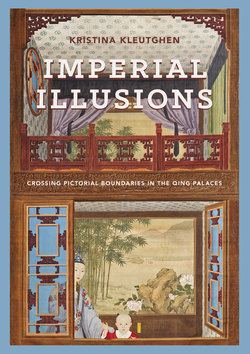Читать книгу Imperial Illusions - Kristina Kleutghen - Страница 26
На сайте Литреса книга снята с продажи.
Оглавлениеpainting would have corresponded to doorways and windows in the original space. If there had been a doorway or windows in the west wall of the Hall of Mental Cultivation, for example, they would have been incorporated into the composition of Spring’s Peaceful Message. Instead, the moon gate in the painting creates a fictive aperture in the wall, which is otherwise entirely covered by the painting.
Successfully integrating a scenic illusion visually into a space also required that the real architectural frame surrounding the painting be incorporated into the painting itself in order to correspond to the viewer’s expectation of the surroundings. Indeed, it is this continuation of the surrounding architectural frames (what has been described as architectural colonization of an illusionistic painting’s borders) that suggests the works are emphatically not paintings.40 In the scenic illusion of Spring’s Peaceful Message, the porcelain-tiled floor (an unusual element that differed markedly from the standard dark stone flooring of the Forbidden City) and latticed windows were repeated in the work, as was the latticework at the top and upper corners of the painting that mimicked the latticework surrounding the real doorway into the room in figure I.1. Other paintings still in situ also demonstrate the consistent practice of painting architectural elements continued from or very similar to those in the real room into the extreme foreground of the paintings, serving to increase the illusion by linking the painting to that particular space and site.
Beyond the visual contiguity of painting and architecture, scenic illusions had to present subjects that would not have been out of place in their surroundings. Furthermore, because scenic illusions derived their subjects and meanings from how and why Qianlong used the sites where they were installed, the subject also had to carry a deeper meaning related to the significance of the building to him personally. The growing study of interiors within art and architectural history has demonstrated that occupant and interior each helps create the other, particularly in the case of monarchs and their palaces.41 Most individual, named spaces in the Qing imperial palaces and garden residences carried a particular meaning, even spaces as small as a single room in a larger building, such as the Three Rarities Studio within the Hall of Mental Cultivation. The name of a site often alluded to this meaning, conveying something of the function of the space as well as a network of historical and literary allusions personally significant to the emperor. For example, Qianlong named the Three Rarities Studio after three pieces of early calligraphy by the most famous calligraphers in Chinese history, which he succeeded in acquiring for the imperial collection. Objects such as these are still part of the former Qing imperial collection, and are also seen in the small Spring’s Peaceful Message, as connoisseurship of antiques in a garden was equally appropriate for literati and for emperors. Although the same antiques are not repeated in the scenic illusion, the fact that the studio was just to the left of the painting implied that real objects from the studio could be brought out into the fictive garden for connoisseurship. To understand a scenic illusion, therefore, one must not only understand the building in which it was installed, but also how Qianlong engaged with it as the primary intended occupant in his own private space.42
